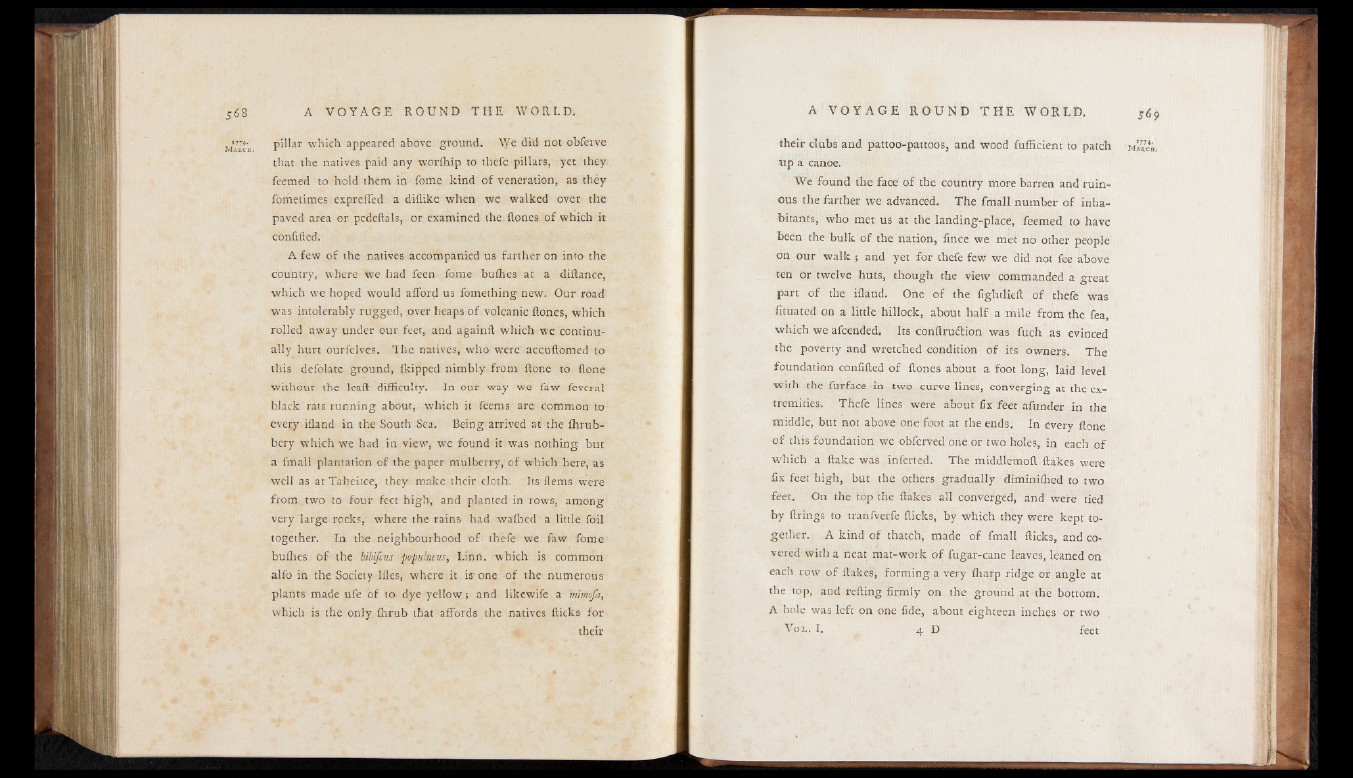
S6 8 A V O Y A G E ROUND THE WORLD.
1774-
M a r c h . pillar which appeared above ground. We did not obferve
that the natives paid any worfhip to thefe pillars, yet they
feemed to hold them in fotire kind of veneration, as they
fometimes expreffed a diflike when we walked over the
paved area or pedeftals, or examined the Hones of which it
confided.
A few of the natives accompanied us farther on into the
country, where we had feen fo.me bufhes at a didance,
which we hoped would afford us fomething new. Our road
was intolerably rugged, over heaps of volcanic dones, which
rolled away under our feet, and againd which we continually
hurt ourfelves. The natives, who were accudomed to
this defolate ground, fkipped nimbly from done to done
without the lead difficulty. In our way we faw feveral
black rats running about, which it feems are common to
eveiy idand in the South Sea. Being arrived at the fhrub-
bery which we had in view, we found it was nothing but
a fmall plantation of the paper mulberry, of which here, as
well as at Taheitee, they make their cloth. Its dems were
from two to four feet high, and planted in rows, among
very large rocks, where the rains had wafhed a little foil
together. In the neighbourhood of thefe we faw fome
bufhes of the hibifcus populneus, Linn, which is common
alfo in the Society Ides, where it is~ one -of the numerous
plants made ufe of to. dye yellow; and likewife a mimofa,
which is the only fhrub that affords the natives dicks for
their
A V O Y A G E R O U N D THE WORLD. 569
their clubs and pattoo-pattoos, and wood fufficient to patch
up a canoe.
We found the face of the country more barren and ruinous
the farther we advanced. The fmall number of inhabitants,
who met us at the landing-place, feemed to have
been the bulk of the nation, lince we met no other people
on our walk ; and yet for thefe few we did not fee above
ten or twelve huts, though the view commanded a great
part of the ifland. One of the lightlied of thefe was
fituated on a little hillock, about half a mile from the fea,
which we afcended. Its condrudtion was fuch as evinced
the poverty and wretched condition of its owners. The
foundation confided of fiones about a foot long, laid level
with the furface in two curve lines, converging at the extremities.
Thefe lines were about fix feet afunder in the
middle, but not above one foot at the ends. In every ftone
of this foundation we obferved one or two holes, in each of
which a flake was inferted. The middlemod flakes were
fix feet high, but the others gradually diminifhed to two
feet. On the top the flakes all converged, and were tied
by firings to tranfverfe flicks, by which they were kept together.
A kind of thatch, made of fmall flicks, and covered
with a neat mat-work of fugar-cane leaves, leaned on
each row of flakes, forming a very fharp ridge or angle at
the top, and refling firmly on the ground at the bottom.
A hole was left on one fide, about eighteen inches
V ol. I. 4 D
or two
feet